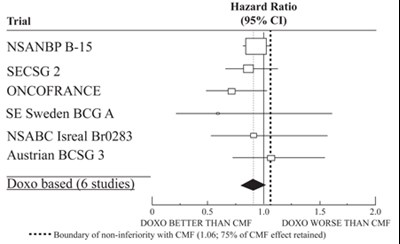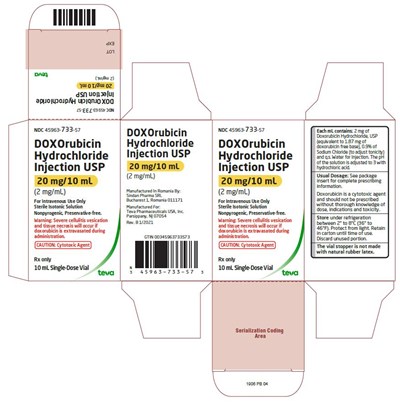Product Images Doxorubicin Hydrochloride
View Photos of Packaging, Labels & Appearance
Product Label Images
The following 7 images provide visual information about the product associated with Doxorubicin Hydrochloride NDC 45963-733 by Actavis Pharma, Inc., such as packaging, labeling, and the appearance of the drug itself. This resource could be helpful for medical professionals, pharmacists, and patients seeking to verify medication information and ensure they have the correct product.
2 - image 2

The text appears to be showing different Hazard Ratios for various trials conducted in different countries with different medications. It also mentions that Doxorubicin (Doxo) based treatment was found to be better than CMF in six studies. However, it also suggests that the non-inferiority boundary with CMF was not met for Dox based treatment.*
3 - image 3

The text describes a table with hazard ratios and some acronyms possibly related to medical studies of treatments. It is not clear what the treatments and medical conditions referred to are.*
1 - image 4

This seems to be a package insert for a medication called DOXOrubicin Hydrochloride Injection USP. It describes the medication, dosage, and warnings for use. The medication is meant for intravenous use only and is provided in a single-dose vial. It should be stored under refrigeration and discarded if unused. The medication should be used with caution as it can cause severe cellular damage if it is not used properly or if it leaks into surrounding tissues. The warning advises against prescribing the medication to people who have allergies to natural rubber latex. The text includes a pharmacy's location in Romania where the medication can be purchased, and there is a section on the packaging labeled Serialization Coding Area.*
image 5

This text is the description of a medication named DOXOrubicin Hydrochloride Injection USP. It is a cytotoxic agent that should not be prescribed without proper knowledge of the dosage recommendations and toxicity. It comes in a 20 mg/10 mL single-dose vial for intravenous use only. The solution is adjusted to pH 3 with hydrochloric acid and contains Doxorubicin Hydrochloride, sodium chloride, and water for injection. It is manufactured in Romania and distributed by Tova Pharmaceuticals USA Inc. The medication should be stored under refrigeration between 2 to 8 °C, and the unused portion should be discarded. Severe cell vesication and tissue necrosis may occur if Doxorubicin is extravasated during administration. The vial stopper is not made with natural rubber latex.*
image 6

DOXOrubicin Hydrochloride Injection USP is a cytotoxic agent used for intravenous use only. The solution must be protected from light and stored under refrigeration. The usual recommended dosage should be taken after thorough knowledge of the drug's indications and toxicity. Severe cellulis vesiation and tissue necrosis will occur if DOXOrubicin is extravasated during administration. Each ml of the solution contains Doxorubicin Hydrochloride, USP equivalent to 10.187 mg of DOXOrubicin free-base, Sodium Chloride, and water. The vials are single-dose and should be discarded after use. The text also contains manufacturing details and contact information.*
image 7

DOXOrubicin Hydrochloride Injection USP is a cytotoxic agent used for intravenous use only. It is available in 100 mL multi-dose vials and contains 200 mg per 100 mL (2 mg/mL) of a sterile isotonic solution that is nonpyrogenic and preservative-free. The solution also contains a warning that severe cellulitis vesication and tissue necrosis will occur if DOXOrubicin is extravasated during administration. It should only be prescribed by someone with a thorough knowledge of its dose, indications, and toxicity. Stored in refrigeration between 2 to 8°C (36 to 46°F), it should be protected from light and retained in the carton until the time of use. The contents of the vial are not made with natural rubber latex.*
* The product label images have been analyzed using a combination of traditional computing and machine learning techniques. It should be noted that the descriptions provided may not be entirely accurate as they are experimental in nature. Use the information in this page at your own discretion and risk.
